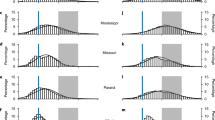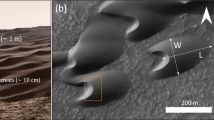Abstract
REVIEWING in the light of later publications, particularly Sven Hedin's “Scientific Results” and Dr. W. P. Hume's “Geology of Egypt,” vol. 1, the observations of sand dunes which I made more than a quarter of a century ago, I have been led to recognise the dynamical significance of the peaked structure which is so marked and picturesque a character in the sand seas of the Gobi, the Tarim basin, and western Egypt.
This is a preview of subscription content, access via your institution
Access options
Subscribe to this journal
Receive 51 print issues and online access
$199.00 per year
only $3.90 per issue
Buy this article
- Purchase on Springer Link
- Instant access to full article PDF
Prices may be subject to local taxes which are calculated during checkout
Similar content being viewed by others
References
See paper on Waves in Granular Material Formed and Propelled by Winds and Currents, Monthly Notices of the R.A.S., Geophysical Supplement, July 1927.
The term short-crested has been introduced by Dr. H. Jeffreys for wave systems in which the distance between consecutive maxima of elevation is of the same order of magnitude in whatever direction it is measured.
Appalachia, vol. 12, No. 1.
Annals of the Astronomical Observatory of Harvard College, 29, Part II.
Rights and permissions
About this article
Cite this article
CORNISH, V. Limits of Form and Magnitude in Desert Dunes1. Nature 121, 620–622 (1928). https://doi.org/10.1038/121620a0
Issue Date:
DOI: https://doi.org/10.1038/121620a0
Comments
By submitting a comment you agree to abide by our Terms and Community Guidelines. If you find something abusive or that does not comply with our terms or guidelines please flag it as inappropriate.



